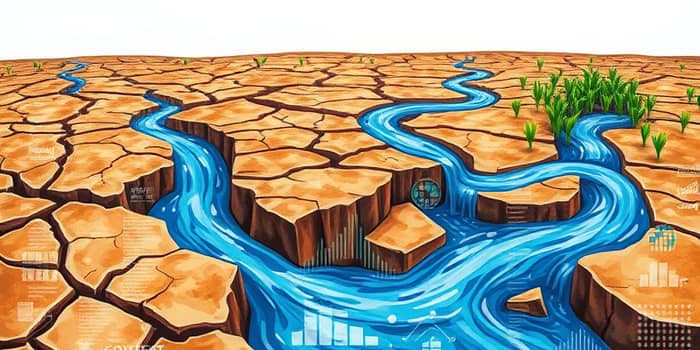
As the world faces an unprecedented water crisis, stakeholders across sectors must recognize both the peril and promise in this essential resource. This article delves into the depths of global water scarcity and highlights strategic pathways for investors and innovators.
Water scarcity is no longer a looming threat—it is our present reality. Over the past century, human water consumption has increased six-fold, stressing natural reserves and ecosystems. Today, 2.2 billion people lack access to safely managed drinking water, and 4.5 billion live without adequate sanitation facilities. By 2025, nearly 1.8 billion individuals will experience “absolute” scarcity, with per capita supplies dropping below 500 cubic meters annually.
The health impacts are dire: every two minutes a child dies from a water-related disease, and waterborne illnesses remain among the leading causes of mortality in low-income regions. Agricultural water consumption is projected to rise by 19% by 2050, while the land area under extreme drought could quintuple, threatening food security and livelihoods.
On a macroeconomic level, shortages force rationing, drive commodity price volatility, and can trigger social unrest and migration. As nations face water-related challenges, investors must understand the scale and urgency of mitigating this crisis through resilient infrastructure and policy reform.
Several interconnected factors exacerbate the global water gap:
Poor infrastructure amplifies these pressures. In many rural areas, storage reservoirs, pumps, and purification facilities are underfunded or nonexistent. Addressing these root causes requires cross-cutting solutions that integrate technology, governance, and finance.
Water stress is geographically uneven, with Northern Africa, the Middle East, South Asia, and parts of China among the most affected. In Sub-Saharan Africa, more than one-third of the population lacks safe drinking water, fueling health crises and limiting economic growth. California’s groundwater basins, drained by agriculture and urban use, may see demand triple supply over the next century, elevating wildfire risk and groundwater subsidence.
Agriculture accounts for roughly 70% of global freshwater usage. Meeting future food demand could require an additional one trillion cubic meters of water per year—the equivalent of diverting 20 Nile Rivers. Meanwhile, energy production is inherently water-intensive: by 2035, increased power generation could boost water withdrawals by 15%, intensifying competition between sectors.
Water scarcity also heightens geo-strategic tensions and migration risks. Communities displaced by drought or contamination often converge on urban centers or cross borders, creating humanitarian and security challenges. Investors must factor these dynamics into risk assessments for regional projects.
Bridging the global water infrastructure funding gap—estimated in the trillions of dollars—poses a formidable challenge. Local markets remain fragmented, and regulatory uncertainty can delay project timelines. The dual nature of water market compels stakeholders to balance public welfare with financial viability, requiring creative financing and governance models.
Water risk has direct implications for corporate performance. Companies that neglect water stewardship face operational disruptions, higher insurance premiums, and damage to brand reputation. In contrast, those implementing robust water management frameworks can secure technology and investment synergy, reduce long-term operational risks, and attract investors prioritizing environmental, social, and governance (ESG) criteria.
Developing reliable business cases often involves sophisticated water accounting, scenario analysis, and engagement with local communities. As such, institutional investors, development banks, and impact funds increasingly collaborate to share risk and mobilize capital for infrastructure, treatment plants, and efficiency upgrades.
Investor sentiment toward the water sector has strengthened. In 2025, 96% of respondents in industry surveys plan to maintain or increase water-related allocations. Approximately 30% have already deployed over US$500 million in this space, signaling a shift toward long-term, impact-oriented capital. Key areas of focus include:
Across the United States, over $3 trillion in spending is needed to upgrade water-related infrastructure, providing fertile ground for both public and private investment. Water utilities and technology providers enjoy stable, regulated returns, often insulated from the volatility of broader markets.
Cutting-edge technologies are redefining the water landscape. Solar-powered pumps reduce reliance on diesel generators in remote communities, while membrane filtration and reverse osmosis systems deliver potable water from challenging sources. Digital platforms now integrate AI and IoT for predictive maintenance, public-private partnerships drive innovation, and build operational resilience.
Case studies from Israel, Singapore, and the Netherlands illustrate how holistic water management can yield significant savings and environmental benefits. Innovative financing structures—such as blended finance, green bonds, and performance-based contracts—enable stakeholders to share risk and reward equitably.
Advancements in pricing mechanisms, anchored by accurate internal water pricing, encourage conservation and unlock new revenue streams. As resource scarcity intensifies, these market-based approaches will be critical to aligning incentives and scaling solutions.
Water investments are increasingly governed by UN SDG 6, which calls for universal access to clean water and sanitation. ESG frameworks guide capital flows toward projects with clear social and environmental metrics. Governments worldwide are enacting policies to promote water efficiency, mandate reporting, and facilitate nature-based solutions like wetland restoration and watershed management.
Emerging regulations on corporate water disclosure and risk management foster transparency and comparability. Companies integrating water considerations into board-level decision-making and investor communications can enhance stakeholder trust and access to lower-cost capital.
As the water sector attracts growing attention, novel investment vehicles—impact funds, infrastructure trusts, and water-focused private equity—are gaining momentum. Strategic investors can target high-growth niches, including decentralized treatment, digital monitoring, and agricultural water markets.
By aligning humanitarian goals with financial objectives, stakeholders can transform scarcity into opportunity. Those who deploy capital judiciously and embrace innovation will emerge as emerging future market leaders in water, shaping a sustainable future while delivering resilient returns.
Water scarcity constitutes one of the most critical challenges and promising investment frontiers of our time. With coordinated action, strategic investment, and unwavering commitment, the global community can secure water resources for generations to come and build an equitable, thriving world.
References













